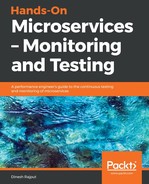Hands-On Microservices – Monitoring and Testing is for all software developers and architects who want to learn about using the microservice architecture for enterprise distributed cloud-based applications. The microservice architecture is particularly useful with cloud-native design patterns. Spring Boot 2.0 and Spring Cloud are used with the microservice architecture. The microservice architecture solves the common design problems of the cloud-native infrastructure in distributed applications, and readers will find the examples presented in this book very helpful. We have covered topics from creating microservices to deploying, testing, and monitoring microservices. Before reading this book, readers should have a basic knowledge of design patterns and Spring Boot.
The microservice is not a new concept in software development; it is one of the oldest patterns of software architecture. But nowadays, industries are using this pattern very widely. We can use Spring Boot 2.0 to create microservice-based applications. Spring Boot 2.0 introduces many new features and enhancements to its previous version. We have another book, Mastering Spring Boot 2.0, which will give you in-depth insights into Spring Boot and the cloud microservices architecture.
The goals of writing this book are to discuss all the topics related to the microservice architecture and to see how to use this software architecture with cloud-native applications. We have discuss both monolithic and microservices software architectures. We also discuss how to distribute a monolithic application in a microservice-based application, and how to deploy and monitor all microservices.
The book contains nine chapters that cover everything from the development of a microservices-based cloud application to the deployment of microservices either by using virtual machines or container systems such as Docker.
Hands-On Microservices – Monitoring and Testing is divided into three parts. The first part introduces you to software architectures, such as monolithic and microservices. Part 2 follows up the explanation of microservices; we will discuss the anatomy of the microservice architecture and microservice deployment patterns. Part 3 expands on that by showing you how to do inter-service communication, and we will discuss various tools and strategies for inter-service communication. Service registry and discovery are other important topics that will be discussed in this book. We will discuss testing and monitoring microservices. Various APM tools are available in the market for monitoring microservices. We will discuss some of these APM tools in this book.
